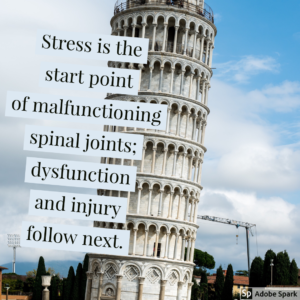
The more invisible stresses are what make your spine vulnerable to injury.
Often long before the ache in your back or crick in your neck was a mental or emotional stress.
Stress has a typical response for all humans. One such response is the inhibition (“turning off”) of the spinal extensor muscles and the subsequent over activation of the body’s front flexor muscles.
You’d recognize this in another, much simpler way — a protective “turtling” posture. It’s wise to slouch forward when a stressful stimuli enters your life. Way back, 100,000+ years ago, when the nervous systems evolved the way it is today, a stressor has very dire consequences. Usually death or severe injuries. So, we learned how to duck for cover. This protected our valuable and vulnerable spots – the face, throat, heart and groin. Good thinking for when a tiger or angry neighbouring tribe jumped out at you.
Today, however, stress is far less often a life or death situation. They’re mental and emotional. They involve relationship challenges, deadlines, financial struggles, or some other invisible, but very felt, compromise to our safety and fruitfulness.
The trick is, our nervous system has hardly evolved over the last 100,000 years where our society has raced forward.
So, we still have a tenancy, even if in only a subtle, nearly impalpable way, to fold forward when challenged by a mental/emotional stressor.
Our extensor muscles – the strong muscles on the back of our body like our glutes, hamstring and spinal muscles – are actually a defining characteristic of what makes us human. They keep us upright unlike our other mammalian cousins. They help us defy gravity on two legs. Without this, we de-volve just that little bit. In so, we become vulnerable.
Our spine becomes weak and less supportive to the physical challenge of everyday life. Suddenly, without pre-warning signs, something as simple as leaning to turn a tap can case an acute and very painful spinal dysfunction or injury.
Chiropractic assessments and adjustments can help you in that troubled moment, but, even before that, it can reverse the asymptomatic (non-painful) dysfunction that would make you vulnerable in the first place.
